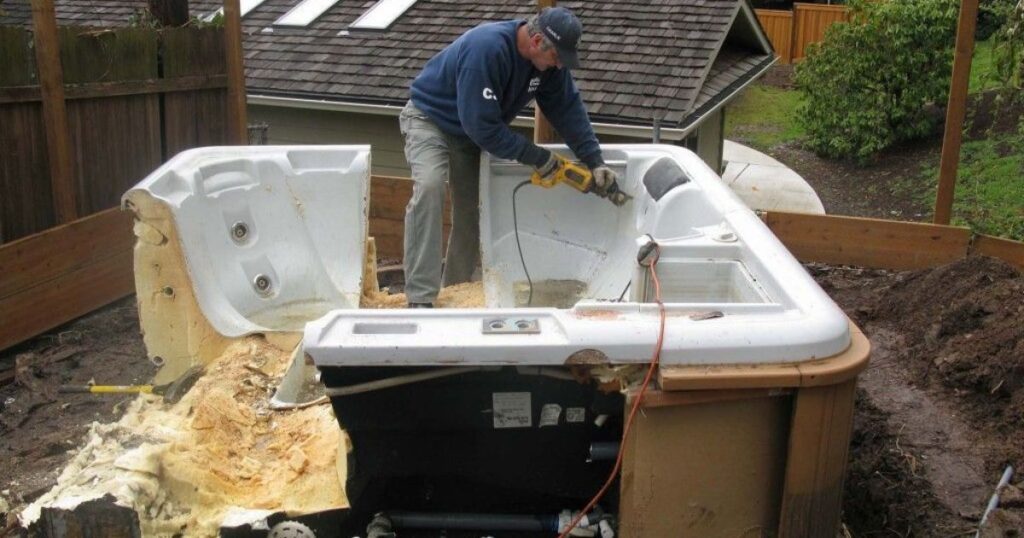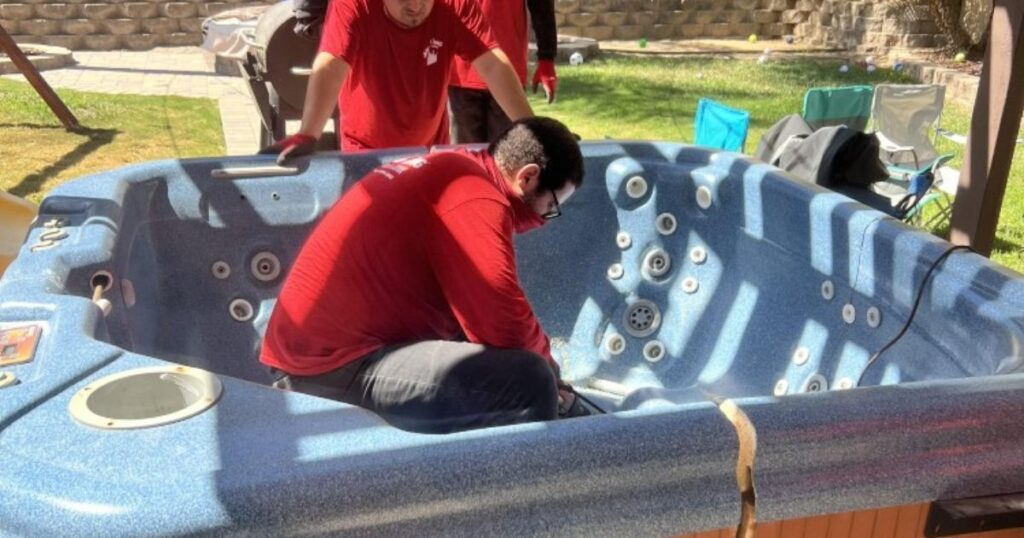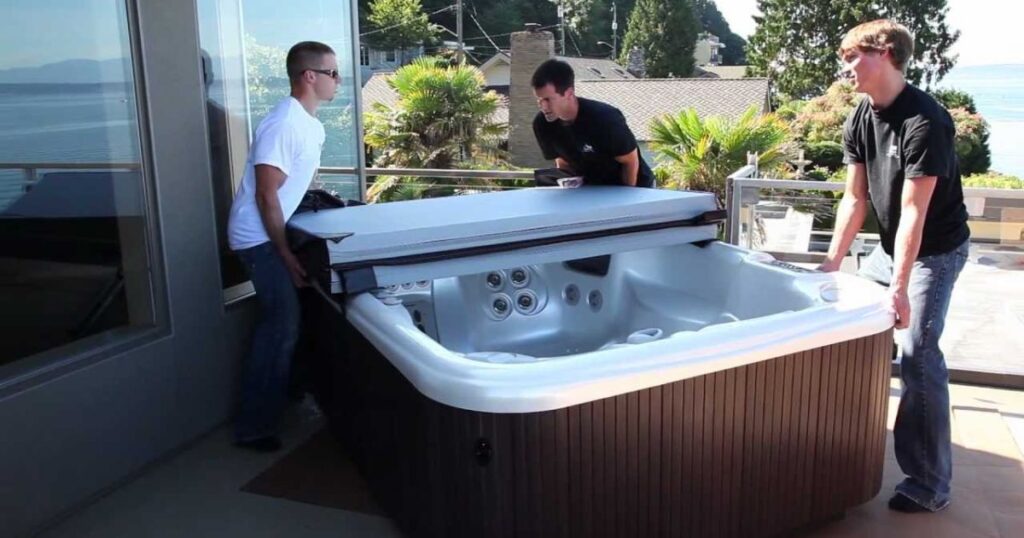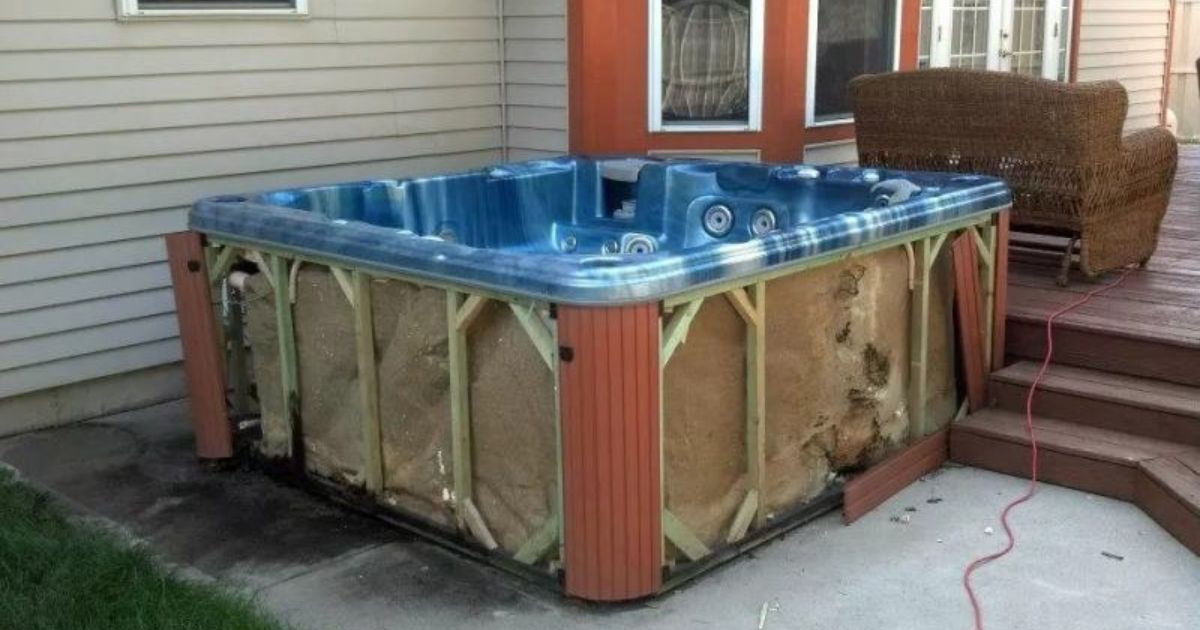Disposing of a hot tub can be a daunting task, whether it’s due to wear and tear, a desire for an upgrade, or a change in lifestyle. Knowing the proper steps for disposal is crucial to ensure not just the removal of the tub but also its environmentally responsible handling. From dismantling to recycling, this guide aims to provide a comprehensive overview of the process. First and foremost, preparation is key. Understanding the structure and components of your hot tub, as well as the potential environmental impact, sets the stage for a smooth disposal.
It involves more than simply disconnecting and discarding; it requires careful planning to mitigate any adverse effects on the surroundings. Safety is paramount throughout this process, both for you and the environment. Exploring disposal options beyond simply dumping the tub into a landfill can offer opportunities for recycling and repurposing materials. By following these steps and considering the broader impact, you can responsibly and efficiently dispose of your hot tub while minimizing ecological footprints.
Preparing for Hot Tub Disposal
Preparing for hot tub disposal involves several crucial steps to ensure a smooth and efficient process. Begin by assessing the hot tub’s size, material, and overall condition to determine the best approach for removal. Disconnect all electrical connections, including power sources and wiring, to guarantee safety during dismantling. Clear the area around the hot tub to provide ample space for the disposal process and make it easier for removal teams, if hired, to access the unit.
Before starting the dismantling process, gather the necessary tools, such as wrenches, saws, and protective gear like gloves and goggles, to safely disassemble the tub. Drain all water from the hot tub completely, either by using a drain valve or siphoning out the water, ensuring there’s no residual moisture left. Consider seeking assistance or professional help if you’re uncertain about disconnecting or handling specific components, especially those involving gas lines or complex electrical systems.
Additionally, research local disposal regulations or guidelines, as some areas may have specific requirements for hot tub disposal. This preparation stage, along with understanding ‘How To Clean Hot Tub Filter?‘, sets the groundwork for a successful disposal process and ensures safety measures are in place before moving forward with dismantling and removing the hot tub.
Steps to Drain and Disconnect
Draining and disconnecting a hot tub is a crucial phase in the disposal process. Follow these steps to ensure a safe and efficient removal:
Turn Off Power
Turning off the power to your hot tub is crucial for safety. Locate the circuit breaker linked to the tub, often labeled in the breaker panel. Switch it to the “Off” position to cut electricity flow. Confirm the power’s disconnection using a voltage tester before proceeding with any maintenance, repairs, or disposal.
If unsure, seek guidance from a professional electrician to ensure a safe power shutdown, minimizing the risk of electrical accidents during any work on the hot tub.
Locate Drain Valve
The drain valve, typically positioned near the base of the hot tub, serves as the primary outlet for water removal. It’s commonly situated along the bottom edge or inside the cabinet area. Identifying this valve allows for efficient drainage, facilitating the removal of water from the tub.
Once located, opening this valve permits the water to flow out, enabling a smooth draining process. If the drain valve isn’t easily accessible or visible, referring to the hot tub’s manual or seeking professional guidance ensures proper identification for effective water removal.
Use Siphoning Method
The siphoning method offers a practical way to remove remaining water from a hot tub during disposal. Utilizing a hose, create a siphon by submerging one end inside the tub and keeping the other end lower than the tub’s water level. Start suction by sucking on the hose or use a pump to initiate the flow of water.
Once the siphon begins, water will naturally flow out of the tub. This technique effectively drains residual water, ensuring a dry interior and facilitating a smoother disposal process while preventing potential water damage or flooding in the surroundings.
Disconnect Electrical Connections
Disconnecting electrical connections in a hot tub involves meticulous steps to ensure safety. Begin by turning off the power at the circuit breaker dedicated to the tub. Unplug or disconnect the power supply, control panels, and any wiring, following manufacturer guidelines. Label and organize wires for reassembly or disposal. Check for any remaining power using a voltage tester before handling wires.
If uncertain, seek professional help to disconnect complex electrical components. This process guarantees a secure disconnection, preventing electrical hazards during hot tub disposal.
Handle Gas Lines (if applicable)
If your hot tub utilizes gas, handling the gas lines during disposal is crucial. Begin by locating the gas supply valve connected to the hot tub and ensure it’s turned off securely. Use caution and follow manufacturer guidelines to disconnect the gas line, employing appropriate tools if necessary. Avoid any sparks or open flames during this process.
If unsure or uncomfortable handling gas lines, seek professional assistance to safely disconnect and cap the gas supply before proceeding with the hot tub’s removal. Safety measures are paramount when dealing with gas lines to prevent potential hazards during the disposal process.
Label and Organize Components
Labeling and organizing hot tub components before disposal streamlines the removal process. Properly mark and categorize disconnected parts, noting their positions or functions. Use labels, markers, or storage containers to keep screws, bolts, and small pieces together. This organization ensures easy reassembly if parts are reused or simplifies identification for recycling purposes. Take photos or make diagrams to reference during reinstallation or when seeking disposal advice. This meticulous approach not only aids in efficient disposal but also minimizes confusion, making it simpler for professionals or recycling centers to handle components responsibly.
Secure Loose Parts
Securing loose parts during hot tub disposal is crucial to prevent damage and ensure safe handling. Gather loose components like screws, bolts, or detached elements and organize them in labeled containers. Tightly seal these containers to avoid losing smaller parts during transport or removal.
Additionally, consider using ziplock bags or smaller compartments within the containers to separate and categorize various parts, making reassembly or disposal more manageable. Properly securing loose parts minimizes the risk of damage, loss, or confusion during the disposal process.
By meticulously draining water and disconnecting electrical and gas connections, you’ll ensure a safer and more straightforward disposal process for your hot tub.
Dismantling the Hot Tub

Dismantling a hot tub involves systematic steps to break down the structure for easier removal. Begin by removing the outer panels or siding, unscrewing or unclipping them carefully to avoid damage. Next, detach the access panels and insulation, exposing the internal components.
Disconnect plumbing connections, ensuring water lines are properly drained. Remove the pump, heater, and any electrical or mechanical components, labeling each for identification.
For the shell, cutting it into smaller sections using saws or power tools facilitates handling. Dispose of components according to local regulations or consider recycling options for eco-friendly disposal. Follow manufacturer’s guidelines for safe dismantling to streamline the removal process.
Transportation and Removal
Transporting and removing a hot tub requires careful planning and execution. Once dismantled, assess the weight and size of individual components for easier transportation. Enlist help or hire professionals equipped with proper lifting and moving tools. Securely pack smaller parts to prevent loss or damage during transit. Use a sturdy vehicle with enough space, like a truck or a trailer, ensuring the tub and its parts fit securely.
Safely load each component, securing them with straps or ties to prevent shifting. When disposing of the hot tub, follow local disposal regulations or consider recycling options to minimize environmental impact. Proper transportation ensures a smooth and safe removal process.
Recycling or Disposal Options
When considering recycling or disposal options for a hot tub, several environmentally conscious avenues exist:
Recycling Centers: Some centers accept hot tubs for recycling, salvaging materials like plastic, metal, and even the shell for repurposing.
Scrap Yards: Metal components, like stainless steel frames or copper wiring, can often be recycled at scrap yards.
Specialized Disposal Services: Numerous companies specialize in hot tub disposal, dismantling units and ensuring proper recycling or disposal of its components.
Local Waste Management: Contact local waste management or recycling facilities to inquire about their policies regarding hot tub disposal.
Donation or Reuse: If the hot tub is in good condition, consider donating it to organizations or individuals who might refurbish or reuse it.
Manufacturer Take-Back Programs: Some manufacturers offer take-back programs for old units, recycling parts and materials responsibly.
Always adhere to local regulations and guidelines when disposing of a hot tub, ensuring eco-friendly practices to minimize environmental impact.
Safety Measures During Disposal

Ensuring safety during hot tub disposal involves several key measures:
Protective Gear
Protective gear is essential during hot tub disposal to shield yourself from potential hazards. Wear sturdy work gloves to safeguard hands from sharp edges, splinters, or chemicals. Goggles or safety glasses protect your eyes from debris or particles when dismantling or cutting materials. Sturdy footwear with slip-resistant soles offers stability and protection from heavy objects or potential falls.
Additionally, consider wearing long-sleeved clothing to minimize skin exposure to dust, chemicals, or rough surfaces. Prioritizing the use of proper protective gear reduces the risk of injuries and ensures a safer disposal process.
Power Isolation
Having assistance or working as a team is crucial during hot tub disposal to ensure safety and ease. Heavy components, like the tub shell or mechanical parts, can be challenging to lift or maneuver alone. Enlist the help of friends, family, or professionals to share the workload and reduce the risk of strains, injuries, or accidents.
When lifting or moving bulky sections, coordinate movements and use proper lifting techniques to avoid strains or mishaps. Having extra hands not only makes the process smoother but also minimizes the chances of accidents, ensuring a safer disposal experience overall.
Secure Dismantling
Secure dismantling during hot tub disposal involves a methodical approach to safely take apart the unit. Begin by carefully removing outer panels or siding, using appropriate tools to avoid damage. Proceed to detach access panels and insulation, exposing internal components. Take caution when disconnecting plumbing lines, ensuring proper draining to prevent spills. Label and organize removed parts for easier reassembly or disposal. Utilize manufacturer instructions or professional guidance for complex components.
If cutting the shell, use tools safely and precisely to avoid accidents. Prioritizing careful and systematic dismantling ensures a smoother disposal process and minimizes risks of damage or injury.
Teamwork or Assistance
Having help or working in a team is invaluable during the disposal of a hot tub. Some components can be heavy or awkward to handle alone, so having others to assist can make the process smoother and safer. When lifting or moving bulky parts, coordinate with others to ensure proper handling and reduce the risk of strains or accidents.
Teamwork also aids in maneuvering the tub out of tight spaces or through doorways. Whether it’s friends, family, or professionals, their assistance not only eases the physical burden but also enhances safety, ensuring a more efficient and secure disposal process.
Gas Line Safety (if applicable)
Ensuring gas line safety during hot tub disposal is crucial if the unit utilizes gas. Begin by locating the gas shut-off valve and turning it clockwise to stop the gas supply. Exercise caution and, if uncertain, seek professional assistance to safely handle the gas line.
Adequate ventilation in the disposal area is vital to dissipate any residual gas. Avoid ignition sources and conduct a thorough check for leaks using gas detectors or soapy water on connections. Prioritizing these precautions minimizes the risk of gas-related mishaps, promoting a safer and more secure hot tub disposal process.
Proper Disposal Handling
Proper disposal handling of a hot tub involves adhering to local regulations and environmentally friendly practices. Separate and dispose of components responsibly, considering recycling options for materials like plastics, metals, and electronic parts. Ensure chemicals or hazardous substances are disposed of according to guidelines to prevent environmental contamination.
If applicable, utilize specialized disposal services or recycling centers equipped to handle bulky items. By following proper disposal protocols and exploring recycling avenues, you minimize environmental impact while safely removing the hot tub from your property.
Caution with Tools
Exercising caution with tools during hot tub disposal is paramount for personal safety and effective dismantling. Use tools suitable for the task and handle them with care, following manufacturer instructions. Keep blades and cutting tools away from your body and other people, ensuring a secure grip to prevent slips.
Always wear appropriate protective gear, like gloves and goggles, to shield against potential injuries from sharp edges or flying debris. Prioritize a steady and controlled approach, avoiding rushed movements or excessive force. Practicing careful tool handling minimizes risks and promotes a safer disposal process overall.
By prioritizing safety at every step, from disconnecting power sources to handling tools and hazardous materials, you can ensure a secure and injury-free hot tub disposal process.
Professional Services for Hot Tub Removal

Professional services for hot tub removal offer expert assistance in disposing of your unit. These services often include assessment, dismantling, transportation, and responsible disposal. Trained professionals equipped with proper tools and expertise handle the entire process efficiently, ensuring safety and minimizing potential damage to your property.
They have experience in dealing with various types of hot tubs and understand the complexities involved in their removal. Hiring professionals not only saves time and effort but also ensures compliance with local regulations for disposal, providing peace of mind throughout the disposal process.
Aftercare and Site Restoration
After hot tub disposal, site restoration is essential to return the area to its original state. Begin by cleaning the space where the hot tub once stood, removing debris and tidying the surroundings. Address any damage caused during removal, such as scratches or marks on surfaces.
Check for potential electrical or plumbing connections that need to be safely capped or sealed off. Finally, consider landscaping or rearranging the area to reclaim the space. Site restoration not only enhances the aesthetics but also ensures safety and usability of the area after hot tub removal, completing the disposal process thoroughly.
FAQ’s
Can you cut up a hot tub to get rid of it?
For this, you will need to don safety gear and cut it up with your Sawzall. This process will be messy as it will produce lots of dust and debris as you saw into the tub.
Why are hot tubs so romantic?
This low lighting gives off a soft and warm ambience, which is ideal for getting lost in deep conversation with your loved one.
How deep is a hot tub?
Hot tubs are typically around 36” high with a depth of about 31”. Of course, that can vary. Some are as shallow as 24” deep with 28” walls, but that is not as common. The average tub will not exceed 42″ high with a depth of 36”.
Is it OK to make love in a hot tub?
Those who have sex in water are also at risk of sexually transmitted infections (STIs), while there is a higher risk of vaginal irritation and urinary tract infections (UTIs).
How big is a 12 person hot tub?
The average 12-person hot tubs are going to most likely be extra large hot tubs or swim spas. They are around 12 feet long and eight feet wide, which would leave it holding somewhere in the ballpark of 1,260 gallons of water.
Conclusion
Disposing of a hot tub involves a series of systematic steps, from preparation to site restoration, ensuring a smooth and responsible process. Beginning with thorough preparation, including draining and disconnecting, the dismantling phase requires caution and proper tool usage. Recycling or disposal options offer eco-conscious ways to handle various components, minimizing environmental impact.
Prioritizing safety measures throughout, from power isolation to teamwork, guarantees a secure disposal experience. Seeking professional services streamlines the process, ensuring efficient and compliant removal. Finally, post-disposal site restoration ensures the area returns to its original state, completing the disposal cycle.
Understanding the local regulations and environmental implications of disposal is crucial, promoting a conscientious approach. By following these steps and considering recycling options, one can responsibly dispose of a hot tub, minimizing waste and potential harm to the environment while reclaiming valuable space.








